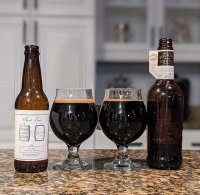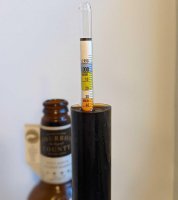Follow up on a version I made last year (see
post #308):
This was my second attempt at a clone. I toasted and charred my own White Oak for this batch. After my first attempt, aged with about 4 oz of oak which had previously been soaked in 45% ABV Makers Mark Whiskey, didn't have anywhere near sufficient whiskey character I reasoned that part of the issue could be due to the real BCBS being aged with Barrel Proof Spirit which is about 60% ABV. To test this out, I aged this batch with about 6 oz of oak which had been soaked in Everclear diluted down to 60% ABV. My beer ended up stopping at a FG of 1.055 rather than at the target of 1.040. It tasted good so I decided to let it ride.
View attachment 702977
View attachment 702978
I aged the beer for 7 months on oak before bottling. The beer is delicious but, upon doing a side by side tasting (see
blog post for this) with the real BCBS, I found that the balance of mine was way, way off (don't make my mistake with such a high FG) - too sweet. Additionally, the whiskey character was a bit improved with the 60% spirt soaked oak but it was still nowhere near as prominent as in BCBS
So, this was another tasty beer but a failure as a clone to BCBS.
For my third attempt (brewed back in August 2020), I've done a bit of re-assessment of the approach to oaking to match the profound whiskey character of BCBS.
- Oak preparation using 6x1x1 inch White Oak sticks toasted for 4 hrs and then charred aggressively, to get an alligator char, produces a sprit with lovely caramel and vanilla along with a perceived sweetness
- Aging with a 60% spirit provides a significantly increased flavor intensity over 45% spirit. I think this additional strength, if used in the correct volume, is a critical factor for cutting through the bold flavors of the BCBS base
- 6 oz of oak isn't enough. Evaluating oak additions by weight is maybe a flawed concept.
I've done some analysis to determine how much oak I should be using. I have a couple interesting data points to arrive to an interesting conclusion:
- First, and most obvious, is an assessment by surface area:
- A 53 gal barrel exposes each gal to 56 square inches of oak on average
- If I use a 6x1x1 inch oak stick at 26 square inches I would need 2 sticks per gal and a whopping 12 of these sticks for a 6 gal batch. I had used 3-4 of these sticks in my last batch
- Now, of course, a barrel doesn't expose end grain to the liquid as my sticks do which, we'd hypothesize, might change the way spirit absorbs into and interacts with the wood in some meaningful way
- For my second analysis, I've done an assessment on the absorption of 60% spirit into wood:
- The oak barrels used to age BCBS are freshly drained and have spirit soaked into the wood. This is pulled from the wood during the long aging of the beer to flavor the beer and increase the alcohol percentage. Looking at some numbers:
- BCBS has a target OG of 30 Brix and a target FG of 10.5 Brix for an 11.75% ABV. The bottled beer varies in ABV - you see anywhere from 13-16%. The extra alcohol extracted from the barrel is a big reason for that.
- I have a 2017 BCBS which is 14.1% ABV. 1 gal of the original 11.75% beer would have included 15 oz of pure alcohol while 1 gal of 14.1% beer had increased up to 18 oz of pure alcohol. This is an addition of 3 oz of pure alcohol per gal from the wood.
- Barrel proof spirit is 60% alcohol so we'd need 5 oz of this spirit to add 3 oz of pure alcohol.
- As an interesting sanity check, this would mean that for a 53 gal barrel there was 2 gal of spirit absorbed into the wood after draining. This seems plausible to me.
- I did an experiment where I took 4 sticks of my 6x1x1 inch wood and soaked them in 60% spirit for over a year. These started out weighing 11 oz. After the soak they were up to 20.4 oz. Let's assess these numbers:
- We picked up 9.4 oz of spirt by weight for 4 sticks of oak
- To convert from weight to volume, I weighed 1 cup (8oz) of spirit as 7.4 oz by weight. So, 9.4 oz of spirit by weight is just about 10 oz of spirit by volume
- 4 sticks absorbed 10 oz of spirit by volume which is 2.5 oz absorbed per stick
- So, we would need 5 oz of spirit added per gal to go from 11.75% ABV to 14.1% ABV like BCBS and, per my experiment, I would need 2 sticks per gal to add the equivalent amount of my spirt.
So, in conclusion, it seems that the
2 sticks per gal both closely matches the surface area of a 52 barrel and provides a good approximation of the spirit absorption rate observed in BCBS to get their alcohol increases (despite the end grain)
Based on this analysis I've decided to age my current beer with 12 sticks of 6x1x1 inch oak
View attachment 702982
This is in secondary and aging. I plan to give this until Fall 2021 before bottling. I'd had a stuck fermentation on this batch as well (hung at 1.055 again) but I opted to add some WLP 099 Super High Gravity yeast to it which has gotten it down to the target 1.040. I will follow up with results. If you want to read more about this experiment you can read my
blog post here.
This is a risk to be taking with an expensive and time consuming beer. I'm comfortable with my analysis but would suggest caution to any other brewers trying this prior to seeing some results.


































![Craft A Brew - Safale BE-256 Yeast - Fermentis - Belgian Ale Dry Yeast - For Belgian & Strong Ales - Ingredients for Home Brewing - Beer Making Supplies - [3 Pack]](https://m.media-amazon.com/images/I/51bcKEwQmWL._SL500_.jpg)



























